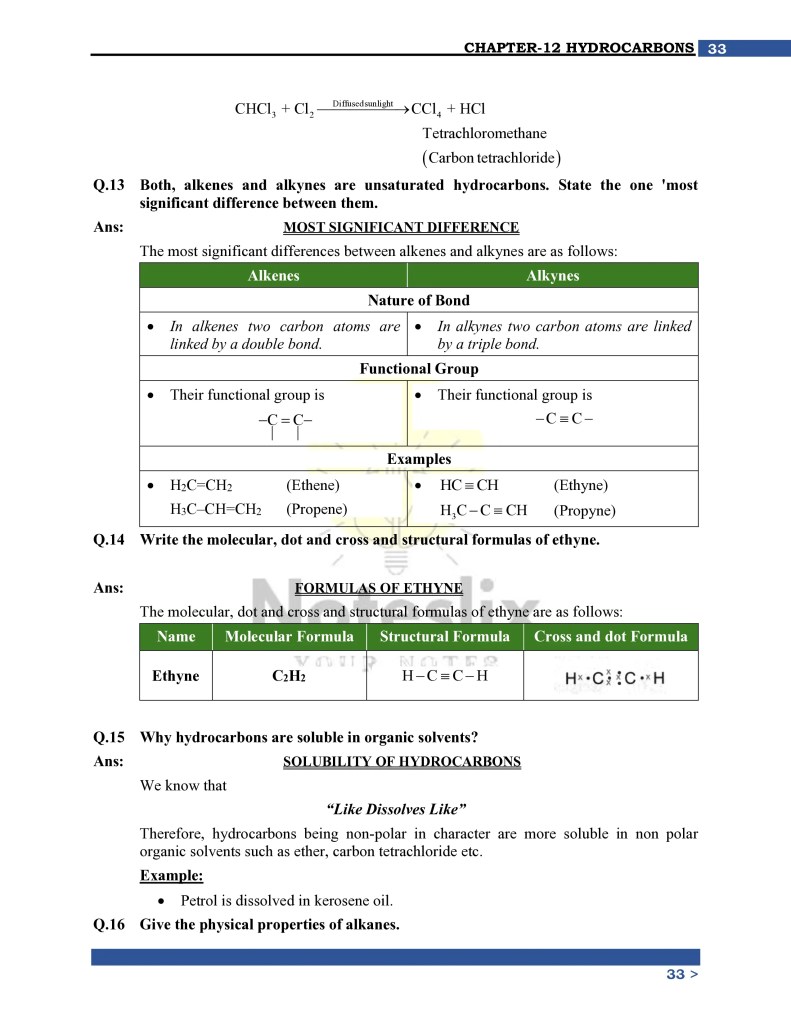Hydrocarbons, the backbone of organic chemistry, form an essential part of Class 10 Chemistry. Chapter 12 dives deep into their properties, types, and applications, providing students with a robust understanding of this fundamental topic.
In this article, we focus on the solved exercises, including MCQs, short questions, and long questions, to offer an exam-centric and structured guide. These notes are specifically designed to make learning efficient, providing all the key points in an easy-to-follow format.











Topics Covered in These Notes
Chapter 12 extensively covers various aspects of hydrocarbons, ensuring a thorough understanding of their structure, classification, and uses. Some of the key topics included in the solved exercises are:
- Definition of Hydrocarbons
Organic compounds consisting of only carbon and hydrogen atoms. - Classification of Hydrocarbons
- Alkanes (Saturated Hydrocarbons): Single bonds between carbon atoms.
- Alkenes and Alkynes (Unsaturated Hydrocarbons): Contain double or triple bonds, respectively.
- Physical and Chemical Properties
Insights into solubility, combustion, and reactivity. - Applications of Hydrocarbons
- Use as fuels and in the production of plastics, detergents, and synthetic fibers.
These solved exercises address the most important topics in a concise yet comprehensive manner.
Class 10 Chapter 12 Solved Exercise (MCQs, Short Questions, and Long Questions)
This section compiles all the essential questions, making it easier for students to grasp the core concepts. It includes:
Multiple Choice Questions (MCQs)
- Identify the simplest class of hydrocarbons:
- (A) Carbides
- (B) Hydrocarbons
- (C) Carbonates
- (D) Nitrates
- Which hydrocarbons form stable chains through single, double, or triple bonds?
- (A) Oxygen
- (B) Hydrogen
- (C) Carbon
- (D) Nitrogen
Short Questions
- What are saturated hydrocarbons?
Saturated hydrocarbons, also called alkanes, are compounds in which carbon atoms are connected solely by single covalent bonds. - Why are hydrocarbons non-polar?
Hydrocarbons are non-polar due to similar electronegativities of carbon and hydrogen atoms, leading to equal charge distribution.
Long Questions
- Explain the classification of hydrocarbons with examples.
Hydrocarbons are divided into:- Saturated Hydrocarbons: Methane (CH₄), Ethane (C₂H₆)
- Unsaturated Hydrocarbons: Ethene (C₂H₄), Ethyne (C₂H₂)
- Discuss the physical properties of alkanes.
- State: Low molecular weight alkanes are gases; medium ones are liquids, and high molecular weight alkanes are solids.
- Solubility: Alkanes are insoluble in water but dissolve in non-polar solvents.
Tool for Success in Exams
These notes serve as an indispensable tool for students aiming to excel in their exams. The structured format ensures clarity, while the inclusion of common exam questions simplifies preparation. By practicing these solved exercises, students can master the key concepts and boost their confidence.
Colored Notes
To enhance understanding and make revision easier, these notes are structured with a clear and visually appealing format. Key points and important terms are highlighted, ensuring that students can quickly identify and focus on the essential content.
- Important Definitions and Examples
- Hydrocarbons: Organic compounds of hydrogen and carbon, such as methane (CH₄) and ethane (C₂H₆).
- Alkenes: Hydrocarbons with double bonds, e.g., ethene (C₂H₄).
- Alkynes: Hydrocarbons with triple bonds, e.g., ethyne (C₂H₂).
- Detailed Diagrams and Tables
- Tables summarizing properties of hydrocarbons, their general formulas, and classifications.
- Structural diagrams of saturated and unsaturated hydrocarbons for better visualization.
Notes Are Free to Use
These notes are freely available to students, ensuring that everyone can benefit from high-quality learning resources. Sharing and accessibility are key aspects, promoting an inclusive educational environment where no student is left behind.
Notes Are Mistake-Free
The content has been meticulously reviewed to eliminate any errors, ensuring accuracy and reliability. Teachers and subject experts have verified every piece of information, making these notes a trustworthy resource for both students and educators.
Conclusion
Chapter 12 of Class 10 Chemistry, focusing on hydrocarbons, provides foundational knowledge crucial for understanding organic chemistry. These solved exercises, with their structured and simplified presentation, offer students a clear path to mastering the topic.
With carefully designed MCQs, short questions, long questions, and error-free content, these notes ensure that students are fully prepared for their exams. By integrating these resources into their study routine, students can significantly enhance their performance and confidence.
Other Class 10th Chemistry Exercises
- Class 10th Chemistry Chapter 9 Exercise
- Class 10th Chemistry Chapter 10 Exercise
- Class 10th Chemistry Chapter 11 Exercise
- Class 10th Chemistry Chapter 13 Exercise
- Class 10th Chemistry Chapter 14 Exercise
- Class 10th Chemistry Chapter 15 Exercise
- Class 10th Chemistry Chapter 16 Exercise

